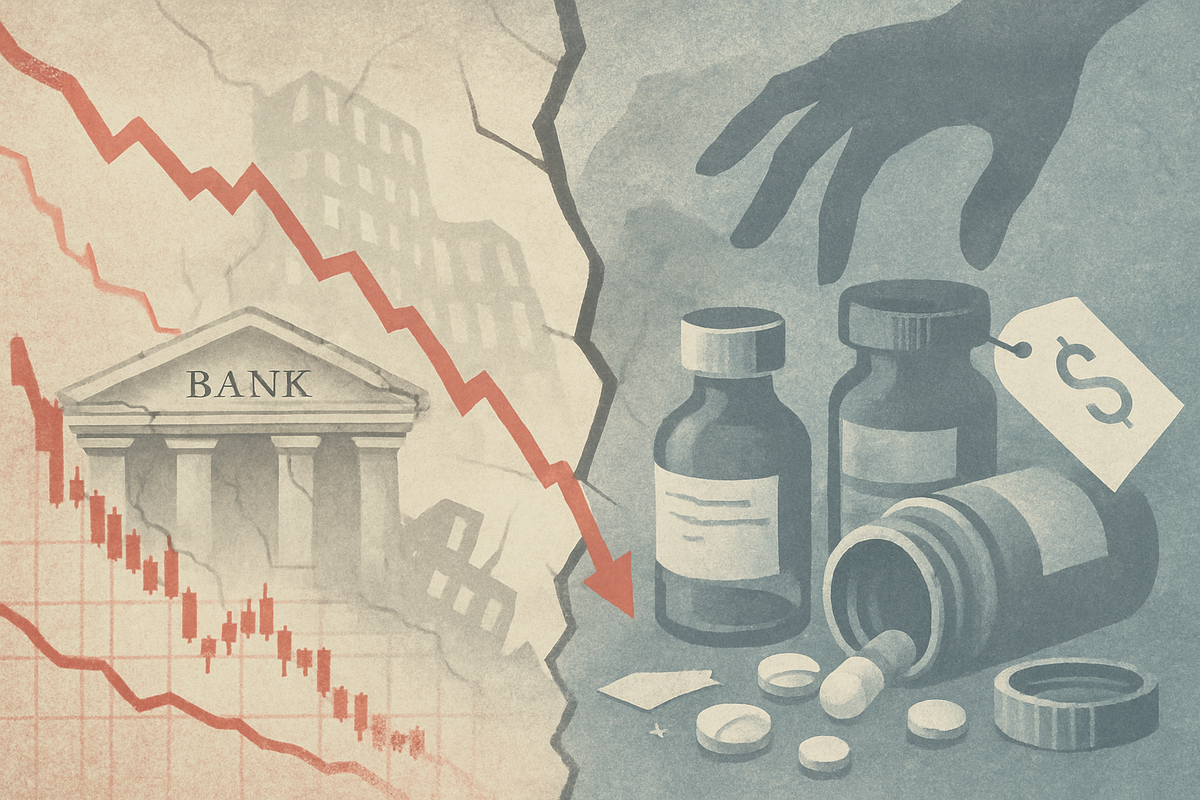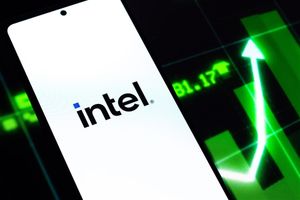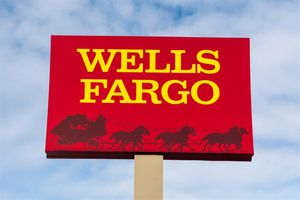
The financial markets experienced a turbulent Friday, October 17, 2025, as the Dow Jones Industrial Average faced a downturn driven by a resurgence of fears within the banking sector. Concurrently, pharmaceutical giants Eli Lilly (NYSE: LLY) and Novo Nordisk (NYSE: NVO) saw their shares plummet following a new round of comments from former President Donald Trump regarding the aggressive reduction of drug prices. This confluence of events has sent ripples through the market, highlighting persistent vulnerabilities in regional banking and the significant influence of political rhetoric on corporate valuations.
Investors reacted swiftly to disclosures of potential loan losses and fraud allegations at smaller lenders, reigniting anxieties reminiscent of the 2023 regional banking crisis. Simultaneously, Trump's explicit targeting of popular weight-loss drugs like Novo Nordisk's Ozempic with promises of drastic price cuts immediately triggered a sell-off in companies heavily invested in the burgeoning GLP-1 market. The immediate implications point to a heightened period of market uncertainty, a flight to safety among investors, and a re-evaluation of risk across both the financial and pharmaceutical sectors.
Detailed Coverage of a Tumultuous Week
The past week, culminating on Friday, October 17, 2025, has been marked by significant market volatility stemming from two distinct but equally impactful developments: renewed bank fears and a direct political assault on pharmaceutical pricing.
The Dow Jones Industrial Average (DJIA) experienced a notable drop, with futures signaling a weaker open on Friday, October 17, 2025, following a broader market downturn. This was exacerbated by fresh concerns over the health of regional U.S. banks. The immediate catalyst was alarming disclosures from prominent regional players. Zions Bancorporation (NASDAQ: ZION) saw its shares plunge by as much as 13% after revealing a $50 million charge-off linked to a single borrower within its California Bank & Trust division, alongside a $60 million provision for credit losses for its upcoming third-quarter results, citing "apparent misrepresentations and contractual defaults." Similarly, Western Alliance Bancorporation (NYSE: WAL) faced a stock drop after disclosing a lawsuit filed in August against one of its borrowers, alleging fraud. These revelations amplified investor unease about credit quality across the regional banking landscape, reigniting fears reminiscent of the 2023 regional banking crisis. The KBW Nasdaq Regional Banking Index (NASDAQ: KRX) suffered significantly, plummeting over 6% on Thursday, October 16, and continuing its decline into Friday, marking its steepest drop since April. Larger institutions like Bank of America (NYSE: BAC), Morgan Stanley (NYSE: MS), Goldman Sachs (NYSE: GS), and Citigroup (NYSE: C) also felt the pressure.
Concurrently, on Thursday, October 16, 2025, former President Donald Trump made significant comments during a press conference in the Oval Office regarding the pricing of weight-loss drugs. Trump declared that the prices of these "fat loss drugs," specifically mentioning Novo Nordisk's (NYSE: NVO) Ozempic, would "come down pretty fast" and be "much lower." He suggested that out-of-pocket costs for patients could be reduced dramatically to as low as $150 per month, a sharp contrast to the current U.S. list price of approximately $1,000 to $1,300 per month. Trump has consistently criticized the higher cost of GLP-1 agonists in the U.S. compared to other developed countries, noting that Ozempic could be obtained for $88 in London versus $1,200 in New York.
The immediate market reaction was swift and negative for the pharmaceutical sector. Following Trump's remarks, shares of Eli Lilly (NYSE: LLY) dropped by 4.62% in after-hours trading on October 16 and continued to fall by more than 4% in premarket trading on Friday. Novo Nordisk (NYSE: NVO) shares also fell by 3.74% after-hours and plummeted 5.6% in early Friday trading. These declines were driven by significant investor concerns regarding potential revenue and profit margin impacts due to anticipated drastic price reductions for their blockbuster GLP-1 medications, including Novo Nordisk's Ozempic and Wegovy, and Eli Lilly's Mounjaro and Zepbound.
Companies Navigating a Shifting Landscape
The recent events have created a clear delineation of potential winners and losers across the financial and pharmaceutical sectors, forcing companies to adapt their strategies in response to escalating credit fears and aggressive drug pricing rhetoric.
Regional Banks: Facing Significant Headwinds Regional banks are undoubtedly the primary losers in the current climate of escalating credit fears. Disclosures from Zions Bancorporation (NASDAQ: ZION) and Western Alliance Bancorporation (NYSE: WAL) highlight the vulnerability of the sector. A core issue is the regional banks' substantial exposure to commercial real estate (CRE) loans, which constitute approximately 44% of their loan portfolios. With high office vacancy rates and declining property values, many of these loans are deteriorating. Over $1 trillion in CRE loans are set to mature by the end of 2025, and elevated interest rates are making refinancing difficult, pushing office loan delinquency rates to 10.4%. This situation, reminiscent of the 2023 banking crisis, threatens their profitability and could lead to further consolidation or failures within the sector. The SPDR S&P Regional Banking ETF (NYSEARCA: KRE) experienced a significant drop, reflecting broad market apprehension.
Larger Financial Institutions: Relative Resilience In contrast, larger financial institutions, while not entirely immune, appear more resilient. Banks like JPMorgan Chase & Co. (NYSE: JPM), Bank of America (NYSE: BAC), and Citigroup (NYSE: C) possess diversified portfolios and broader access to funding sources, providing a buffer against localized credit shocks. Historically, large banks tend to gain market share during periods of financial stress as smaller, more vulnerable banks fail or are absorbed. Their lower concentration in CRE loans compared to regional banks also positions them more favorably.
Eli Lilly (NYSE: LLY) and Novo Nordisk (NYSE: NVO): Blockbuster Drugs Under Pressure Both Eli Lilly and Novo Nordisk, dominant players in the booming GLP-1 drug market, face substantial revenue and profit margin risks from potential drug pricing reforms. Trump's explicit comments targeting Ozempic and suggesting price drops from $1,300 to $150 per month signal a drastic reduction. The proposed "Most-Favored-Nation" (MFN) pricing mandate could reduce prices by as much as 59%. Studies suggest that for GLP-1 drugs to be considered cost-effective, semaglutide (Ozempic/Wegovy) might require an 80% price reduction, and tirzepatide (Mounjaro/Zepbound) a 30% reduction.
Novo Nordisk (NYSE: NVO), heavily reliant on its GLP-1 portfolio including Ozempic and Wegovy, faces significant exposure. While their GLP-1 products delivered strong performance, the company's 60.7% market share in weight-loss drugs, with 40% margins, is under threat. Novo Nordisk has already demonstrated pricing vulnerability by slashing Wegovy's price by over 50% on its online pharmacy in early 2025.
Eli Lilly (NYSE: LLY), with its Mounjaro and Zepbound, is rapidly gaining market share and is considered highly effective. Zepbound accounts for 45% of Eli Lilly's company revenue, making it significantly exposed to regulatory pricing interventions. However, Eli Lilly's perceived efficacy advantage with Zepbound and its robust pipeline, including an oral GLP-1 candidate (orforglipron) in Phase 3 trials, might position it slightly better to weather price reductions by maintaining strong market uptake and diversifying its GLP-1 offerings.
Despite the pricing pressures, the overall GLP-1 market is projected to be enormous, potentially reaching $100-150 billion by the early 2030s. Eli Lilly and Novo Nordisk are expected to retain a dominant share (80-90%) of this market for the foreseeable future, even with intensifying competition. While both companies face significant headwinds from pricing discussions, some analysts believe the market's initial negative reaction might be "overdone," as lower prices could unlock higher sales volumes due to increased accessibility.
Wider Significance and Systemic Implications
The recent market events are not isolated incidents but rather critical indicators of broader industry trends, potential ripple effects, and ongoing regulatory and policy debates that carry historical echoes.
Regional Banking Fragility and CRE Exposure: The renewed bank fears underscore the persistent fragility within the regional banking sector. Their concentrated exposure to the struggling commercial real estate (CRE) market, where over $1 trillion in loans are set to mature by the end of 2025, is a systemic vulnerability. This situation fits into a broader trend of tightening credit conditions and declining property valuations, particularly in the office sector. The current anxieties draw stark comparisons to the Savings and Loan (S&L) Crisis of the 1980s and 1990s, which was also fueled by high interest rates and risky CRE lending, leading to widespread failures. The 2023 bank failures (e.g., Silicon Valley Bank, Signature Bank) further highlighted how quickly localized issues can trigger widespread loss of confidence, amplified by technology and social media, even for banks not considered systemically important.
Pharmaceutical Pricing Debates and Political Influence: Donald Trump's comments on drug pricing reignite a long-standing political debate in the U.S. and exemplify the direct influence of political rhetoric on market valuations. His "most-favored-nation" (MFN) approach, aiming to peg U.S. drug prices to the lowest rates in other developed countries, represents a significant policy shift. This contrasts with the Biden administration's approach under the Inflation Reduction Act (IRA), which empowered Medicare to negotiate drug prices directly with manufacturers. The prospect of an MFN policy creates significant uncertainty for pharmaceutical companies, potentially reducing funding for research and development (R&D) and challenging the U.S.'s global leadership in innovation. Historically, presidential comments and policy shifts have often led to immediate market reactions, though the speed and directness are amplified by modern communication and trading technologies.
Ripple Effects Across Industries: The Dow's turbulence, fueled by trade tensions and economic uncertainty, creates a cautious environment for all market participants, particularly companies sensitive to U.S.-China trade relations in sectors like technology. For the banking sector, the fragility in regional banking will likely lead to tighter credit standards, impacting small and minority-owned businesses that rely heavily on regional lenders. It could also accelerate consolidation, with larger banks potentially acquiring struggling regional institutions. In pharmaceuticals, aggressive pricing policies threaten the revenue and profit margins of drugmakers globally, potentially impacting R&D investment. While the stated aim is to lower costs for patients, the actual immediate impact is subject to legal and procedural challenges.
Regulatory and Policy Implications: In the banking sector, post-2023 failures, regulators have focused on revisiting capital requirements for mid-sized banks, enhancing stress testing, and evaluating uninsured deposits in liquidity models. Further bank failures would likely dictate additional regulatory and legislative responses. For drug pricing, Trump's MFN executive orders in 2025 direct the administration to communicate price targets and propose rulemaking if progress isn't made. However, the legal authority to directly intervene in the market this way is unclear, suggesting potential legal battles. A potential future Trump administration might also seek to repeal the IRA, which would remove Medicare's drug price negotiation powers.
What Comes Next: Navigating Uncertainty
The path forward for the Dow, the banking sector, and pharmaceutical companies like Eli Lilly and Novo Nordisk is fraught with both opportunities and significant challenges, demanding strategic pivots and careful navigation in the coming months and years.
For the Dow Jones Industrial Average: In the short term (late 2025), the Dow is expected to exhibit continued volatility, influenced by ongoing economic data, geopolitical developments (such as U.S.-China trade relations and potential government shutdowns), and the lead-up to the U.S. presidential election. While underlying economic fundamentals may remain robust, driven by resilient consumer spending and corporate earnings, investors should anticipate periods of heightened uncertainty. Long-term (beyond 2025), forecasts remain largely optimistic, with projections for the DJIA to reach new highs, fueled by technological advancements (AI, nanotechnology) and global expansion by large-cap companies. However, this growth will likely be punctuated by market corrections. Investors should focus on diversification and quality investments to weather potential volatility.
For the Banking Sector: In the short term, the banking sector will continue to face intense regulatory scrutiny, particularly concerning risk management, cybersecurity, and capital/liquidity adequacy. Regional banks, in particular, must adapt to heightened expectations for credit quality, especially given their exposure to commercial real estate. Loan demand, especially for mortgages, may improve with anticipated interest rate cuts, but consumer loan growth could remain sluggish. Long-term, banks must adapt to evolving data privacy laws, crypto and digital asset regulations, and increasingly stringent ESG disclosure requirements. Strategic pivots will involve optimizing interest income strategies in a potentially lower-rate environment, boosting non-interest income, and investing heavily in AI and digital tools for risk management and operational efficiency. Consolidation through M&A, driven by a potentially more deregulatory administration, could also be a significant trend.
For Eli Lilly (NYSE: LLY) and Novo Nordisk (NYSE: NVO): Trump's drug pricing comments introduce immediate and significant short-term uncertainty. Both companies face intense pressure to recalibrate pricing strategies. There's a possibility that pharmaceutical companies might respond by increasing prices in Europe or delaying the launch of innovative treatments, rather than solely cutting U.S. prices. Proposed tariffs on pharmaceutical imports could also paradoxically drive up U.S. drug costs and create supply shortages.
Eli Lilly (NYSE: LLY) is keenly awaiting data in April 2025 from a late-stage trial for orforglipron, an oral GLP-1 medication. A successful outcome could be a significant growth catalyst and shift market share, potentially sending the stock to record highs. Eli Lilly's strong pipeline and perceived efficacy advantage with Zepbound (tirzepatide) position it well, but it must continue to innovate and diversify its GLP-1 portfolio.
Novo Nordisk (NYSE: NVO), while a market leader with Ozempic and Wegovy, faces direct threats to its margins. The company has already proactively reduced Wegovy's price by 50% on its online pharmacy to retain market share. Novo Nordisk is also developing new GLP-1 agents like cagrisema, with filing for approval expected in late 2025. Both companies must focus on optimizing operating models, reducing costs, and investing in data, AI, and digital tools for R&D and supply chain resilience. Long-term, the overall GLP-1 market is projected for enormous growth, expanding beyond diabetes and obesity into new indications like chronic kidney disease and heart failure. However, the pharmaceutical industry faces a "patent cliff" with over $300 billion in sales at risk through 2030, necessitating continued innovation and strategic M&A.
Comprehensive Wrap-Up: Navigating a Complex Market
The financial markets are currently navigating a complex and interconnected web of financial vulnerabilities, political pressures, and evolving economic conditions. The Dow's recent performance amid renewed bank fears and the sharp sell-off of Eli Lilly (NYSE: LLY) and Novo Nordisk (NYSE: NVO) following Trump's drug pricing comments serve as potent reminders of this intricate landscape.
Key Takeaways: The market's swift reaction to regional bank woes underscores persistent sensitivity to systemic financial stability concerns, particularly given the unresolved issues surrounding commercial real estate exposure. Concurrently, the immediate stock market volatility triggered by political rhetoric targeting the highly profitable pharmaceutical sector highlights the significant and direct influence of government policy on corporate valuations. Both industries are operating under heightened regulatory scrutiny, with governments actively seeking to control costs and reduce consumer burdens, directly impacting corporate profitability.
Market Assessment Moving Forward: Looking ahead, the market is expected to remain dynamic and potentially volatile through 2025. While solid U.S. economic growth, a resilient labor market, and healthy consumer spending are anticipated to underpin corporate earnings, factors such as the Federal Reserve's interest rate trajectory (with expectations of further cuts), persistent inflation, and geopolitical tensions will continue to drive market sentiment. The policies of the incoming U.S. presidential administration, including potential changes to taxes, deregulation, and tariffs, will be a significant source of uncertainty and a key driver of market movements.
Lasting Impact: The 2023 banking crisis and the renewed regional bank concerns in 2025 have left a lasting imprint on the financial sector, leading to heightened regulatory vigilance and a cautious investor stance towards regional banks. The vulnerability of commercial real estate portfolios remains a critical concern. For the pharmaceutical industry, Trump's drug pricing comments and broader policy initiatives signal persistent pricing pressure, potentially eroding profit margins and influencing R&D investment. The industry must now factor political risk and evolving healthcare policy into its long-term strategic planning, recognizing that government intervention can directly influence market access and profitability. The threat of U.S. tariffs on pharmaceutical imports introduces significant risk, potentially leading to higher manufacturing costs, drug shortages, and a push towards onshoring pharmaceutical production.
What Investors Should Watch For: In the coming months, investors should:
- Embrace Diversification and Rebalancing: Maintain a well-diversified portfolio to mitigate risks and capitalize on opportunities amidst expected volatility.
- Focus on Quality: Prioritize investments in companies with strong balance sheets, robust cash flows, and sustainable business models.
- Monitor Macroeconomic Indicators: Keep a close eye on inflation data, Federal Reserve interest rate decisions, and broader economic growth trends.
- Stay Informed on Policy: Be vigilant about updates on U.S. presidential administration policies regarding tariffs, tax reforms, and regulatory changes, particularly in the financial and pharmaceutical sectors.
- Sector-Specific Vigilance: For financials, scrutinize individual bank's exposure to commercial real estate and liquidity. For pharmaceuticals, assess companies based on their ability to adapt to pricing pressures, diversify pipelines, and demonstrate resilience to political scrutiny and potential trade actions.
- Look for Broadening Opportunities: While mega-cap tech stocks have led recent rallies, the market is expected to broaden, suggesting opportunities might emerge in other sectors.
In conclusion, the market is navigating a complex interplay of financial vulnerabilities, political pressures, and evolving economic conditions. While solid fundamentals may provide underlying support, investors should prepare for continued volatility and adopt a strategic, informed approach to capitalize on emerging opportunities while mitigating risks.
This content is intended for informational purposes only and is not financial advice.





